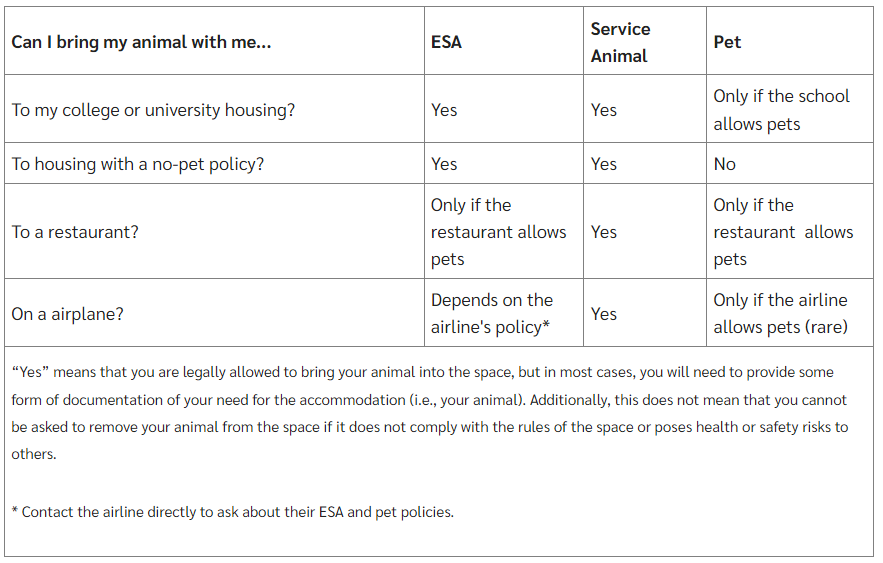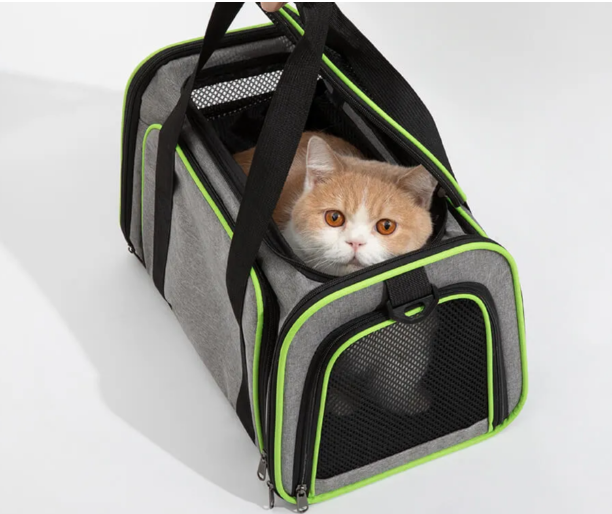Emotional support animals (ESAs) are increasingly popular for mental and emotional support. They offer additional assistance for conditions like anxiety, depression, and post-traumatic stress disorder (PTSD). Licensed mental health professionals can provide proper documentation, granting ESAs specific housing and travel privileges that regular pets don't have.
This guide covers all aspects of living with an ESA in 2023. Learn about the differences between ESAs and service animals, ESAs' rights, and how to register and travel with them.
What’s the Difference Between an Emotional Support Animal and a Service Dog?
To understand emotional support animals(ESAs), it helps to first understand how they differ from service dogs. The main differences include:
1. What’s an emotional support animal?
An ESA is a therapeutic companion animal, such as a dog or cat, prescribed by a licensed mental health professional. ESAs provide comfort and emotional support that can ease symptoms of certain mental health conditions such as depression, anxiety disorders, PTSD, and bipolar disorder. They are not required to have special training.
.png?w=1152&h=896)
2. What Is a service dog?
Service dogs are specially trained to perform specific tasks to assist people with disabilities. They go through rigorous and official training programs to support individuals with disabilities and are protected under the Americans with Disabilities Act (ADA). For example, there are guide dogs for the blind, seizure alert dogs, and dogs trained to remind someone to take medication.
.png?w=1152&h=896)
3. Key differences summarized
- ESAs do not need special training, while service dogs are extensively trained for their role
- Service dogs have the right of public access, while ESAs do not
- ESAs provide emotional comfort, while service dogs perform physical tasks
So in summary, ESAs provide therapeutic benefits while service dogs directly help someone perform daily tasks they couldn’t easily do without their assistance.
How to Get an Emotional Support Animal in 2023
To legally have an emotional support animal, you must obtain an ESA letter from a licensed mental health professional who is currently treating you. Here's what you need to know about getting a valid ESA letter:
1. Letter requirements and qualifications
The letter must state that you have an emotional or mental disability and that the ESA provides therapeutic benefit by alleviating your disability symptoms. Letters purchased online without an ongoing treatment relationship are legally invalid.
You must have a diagnosable mental or emotional disability to qualify for an ESA letter. The condition must limit at least one major life activity.
2. Finding a qualified mental health professional
Your current doctor, psychiatrist, therapist, counselor or other mental health provider who treats you can write the letter. If you don't have a provider, research local options who treat similar conditions and schedule a consultation.
3. Getting your letter online vs. in-person
You need an established relationship for a valid letter. Some websites offer letters without this requirement, but they won't hold up legally. Obtain the letter directly from your qualified mental health provider.

FunnyFuzzy's Soft & Cosy Pet Sofa Cover: A Warm Embrace for Emotional Support Dogs and Their Owners
Do You Need to Register Your Emotional Support Dog or Cat?
Here’s what you need to know about emotional support animal registration:
1. No national registration required
There is no official national registry for ESAs. Any website that claims to be an official ESA registry is misleading—registration is not legally required.
2. Optional registry benefits
While not mandatory, some choose to register their ESA for benefits like ID cards and vests. This can identify your ESA in public and make travel easier, but is not necessary for legal rights.
.png?w=1088&h=896)
Top 5 Benefits of Having an Emotional Support Animal
There are many potential advantages to having an ESA for improved mental health and quality of life. Here are 5 of the top benefits:
1. Reduced anxiety and improved mental health
Interacting with animals has been proven to decrease anxiety, loneliness, depression, and stress. ESAs provide constant companionship.
2. Additional housing rights
Landlords must make reasonable accommodations to normal “no pets” policies for tenants with ESA letters. There are a few exceptions.
3. Travel privileges
With documentation, ESAs can fly in-cabin with their owner instead of as cargo, and live in non-pet friendly hotels for no extra fee.
4. Fosters social interaction
An ESA can spark friendly conversations with others and provide a social connection in public places.
5. Unconditional companionship
Pets provide constant support. ESAs provide motivation to give their owners a sense of purpose.

Where can You Take Your Emotional Support Pet
Flying with an Emotional Support Pet - What’s Allowed?
.png?w=1152&h=896)
According to the U.S. Department of Transportation, traveling by air with an ESA has become more complicated due to recent policy changes. Here is what you need to know if flying with your emotional support dog or cat:
1. Airline Documentation Requirements
Airlines may require documentation no older than one year from the initial flight date that provides:
- Proof of your mental or emotional disability recognized in the Diagnostic and Statistical Manual of Mental Disorders (DSM)
- Statement that you need the ESA for air travel and/or destination activities
- Licensed mental health professional's credentials and licensing info
2. Expected Additional Fees and Forms
While your ESA can fly in cabin, airlines may charge fees, require veterinary records, and mandate forms for your mental health professional to fill out.
3. Tips for Smooth Air Travel
Have your ESA letter handy, attach an ID tag and leash to your pet, and ensure your ESA is trained to behave properly in public. Proper planning will facilitate a smooth air travel experience.
4. Policies of Specific Airlines
Some airlines, such as United Airlines, consider ESAs as pets. You can fly with an emotional support dog or cat in its pet carrier.
Foldable Breathable Pet Carrier Bag
Best Animal Species for Emotional Support
When choosing an ESA, you should consider your lifestyle, living situation, and abilities to care for different types of animals. Some top options include:
1. Dogs
Dogs are the most common ESAs for their trainability, affection, and constant companionship. If you already have a dog, it can indeed become your emotional support dog, provided that you meet the necessary requirements.
2. Cats
Cats can be more independent but still provide comfort and stability. Litter box training is a must.
3. Rabbits, birds, other small animals
Small animals work for those unable to care for dogs/cats. Consider needs like space, exercise, socialization.

Emotional Support Dogs: Offering Consistent Support and Unconditional Love
Conclusion and Key Takeaways
ESAs can provide many benefits, but having one is a responsibility too. Keep these key points in mind:
- ESAs are not service dogs and do not have the right of public access
- You must have an ESA letter from a licensed mental health provider to legally have an ESA
- Know your rights and responsibilities when traveling by air with an ESA
- Make sure you can fully take care of an ESA’s needs before getting one
- Connect with a mental health professional to see if an ESA is recommended for you
ESAs can greatly enhance quality of life for those needing additional comfort and support. Just be sure to educate yourself on the laws and proper procedures for obtaining and traveling with an ESA.
See Also:
Getting an Emotional Support Animal in the UK: Requirements & Benefits
Do Cats Like To Sleep In Dark Or Light?


